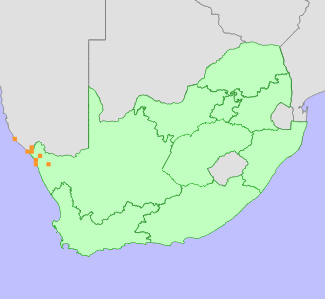|
Scientific Name | Babiana namaquensis Baker |
Higher Classification | Monocotyledons |
Family | IRIDACEAE |
National Status |
Status and Criteria | Vulnerable B1ab(ii,iii,v)+2ab(ii,iii,v) |
Assessment Date | 2021/11/04 |
Assessor(s) | D. Raimondo |
Justification | This species has a national extent of occurrence (EOO) of 6693 km², and area of occupancy (AOO) of 52 km². Between five and 10 locations in South Africa continue to decline as a result of habitat loss due to mining and overgrazing. The population is also declining in Namibia and therefore its national status is not downgraded. It is therefore listed as Vulnerable under criterion B. |
Distribution |
Endemism | Not endemic to South Africa |
Provincial distribution | Northern Cape |
Range | This species is found from Buchuberg in southwestern Namibia to Eksteenfontein in the Richtersveld in the Northern Cape Province of South Africa. |
Habitat and Ecology |
Major system | Terrestrial |
Major habitats | Southern Richtersveld Yellow Duneveld, Richtersveld Coastal Duneveld, Western Gariep Lowland Desert, Alexander Bay Coastal Duneveld |
Description | It occurs on stony coastal and near interior flats and low hills, usually on weathered dolomite outcrops, but also on micaceous schist. The corms are often wedged in rock crevices. |
Threats |
| It is threatened by severe, ongoing habitat loss and degradation due to mining and overgrazing across its range. |
Population |
It is endemic to the Gariep Centre of Endemism of north-western South Africa and southern Namibia, but more than 80% of this species' population is estimated to occur within South Africa, where it is declining due to ongoing habitat loss and degradation. It is also likely to be declining due to habitat loss to mining in Namibia, and therefore the South African population is unlikely to benefit from significant rescue effects from the adjacent Namibian population, and the national status is not downgraded.
It was observed as being common in 2002 in Alexander Bay and only one plant was observed in 2008 in Port Nolloth. No other indication of population size is given in the other records for this species. The population is declining due to loss and degradation of its habitat.
|
Population trend | Decreasing |
Assessment History |
Taxon assessed |
Status and Criteria |
Citation/Red List version | | Babiana namaquensis Baker | VU B1ab(iii,v) | 2015.1 | | Babiana namaquensis Baker | Least Concern | Raimondo et al. (2009) | | Babiana namaquensis Baker | Insufficiently Known | Hilton-Taylor (1996) | |
Bibliography |
Goldblatt, P. and Manning, J.C. 2007. A revision of the southern African genus Babiana, Iridaceae, Crocoideae. Strelitzia 18:1-97. South African National Biodiversity Institute, Pretoria.
Goldblatt, P. and Manning, J.C. 2020. Iridaceae of southern Africa. Strelitzia 42. South African National Biodiversity Institute, Pretoria.
Hilton-Taylor, C. 1996. Red data list of southern African plants. Strelitzia 4. South African National Botanical Institute, Pretoria.
Raimondo, D., von Staden, L., Foden, W., Victor, J.E., Helme, N.A., Turner, R.C., Kamundi, D.A. and Manyama, P.A. 2009. Red List of South African Plants. Strelitzia 25. South African National Biodiversity Institute, Pretoria.
Snijman, D.A. 2013. Plants of the Greater Cape Floristic Region 2: The extra Cape flora. Strelitzia 30. South African National Biodiversity Institute, Pretoria.
|
Citation |
| Raimondo, D. 2021. Babiana namaquensis Baker. National Assessment: Red List of South African Plants version 2024.1. Accessed on 2025/10/18 |
 Comment on this assessment
Comment on this assessment


